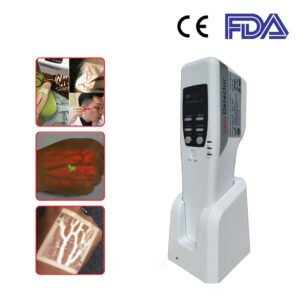Using Vein Finders following Platelet Dysfunction
Platelet diseases can impact the amount of platelets in the body, as well as how efficiently they function. A platelet problem disrupts the proper clotting of blood. Platelet dysfunction can be caused by a variety of disorders, including: Idiopathic thrombocytopenic purpura (ITP) is a type of thrombocytopenic purpura that is (bleeding disorder in which the immune system destroys platelets).
Platelet disorders can affect the number of platelets, how well they function, or both. A platelet disorder affects normal blood clotting.
Disorders that can cause problems in platelet function include:
- Idiopathic thrombocytopenic purpura (bleeding disorder in which the immune system destroys platelets)
- Chronic myelogenous leukemia (blood cancer that starts inside bone marrow)
- Multiple myeloma (blood cancer that starts in the plasma cells in the bone marrow)
- Primary myelofibrosis (bone marrow disorder in which the marrow is replaced by fibrous scar tissue)
- Polycythemia vera (bone marrow disease that leads to an abnormal increase in the number of blood cells)
- Primary thrombocythemia (bone marrow disorder in which the marrow produces too many platelets)
- Thrombotic thrombocytopenic purpura (blood disorder that causes blood clots to form in small blood vessels)
Symptoms may include any of the following:
- Heavy menstrual periods or prolonged bleeding (more than 5 days each period)
- Abnormal vaginal bleeding.
- Blood in the urine.
- Bleeding under the skin.
- Bruising easily or pinpoint red spots on the skin.
If the quantity of platelets is within normal limits, doctors suspect platelet dysfunction. If the cause is unknown, doctors may need to perform blood tests to assess clotting-related chemicals. However, a professional vein viewer is required to do this work.
Based on this critical medical necessity and the high-quality aid that the vein viewer delivers for such procedures, our technical medical staff always recommends considering the FDA Portable Vein Finder SIFVEIN-5.2.
The primary function of this infrared vein finder is to locate veins quickly. That is, this portable vein finder is designed to allow oxyhemoglobin in surrounding tissues and veins to absorb light. After photoelectric conversion and image processing, the data is filtered to display veins on the screen.
Accordingly, this vein viewer is designed to observe search for subcutaneous superficial blood vessels and for assisted puncture. Such as assisted venous diagnosis (like Platelet dysfunction) and intravenous injection.
Most importantly, this portable vein finder uses a new type of optical structure design. That can realize the original position projection and improve the vein recognition rate. It is important to note as well that the following vein viewer functions following a new image enhancement algorithm. Hence, it will surely generate clearer fully digital vein image resolution that has a display mode too.
Furthermore, the infrared vein finder SIFVEIN-5.2 allows veins to be seen clearly in a depth of 10 mm beneath the skin, regardless of the patient’s age, skin color, or obesity level. This vein viewer has a depth recognition mode that improves vein depth judgment thanks to its three colors imaging (red, green, and white) that can be switched at any time based on the light in the room and the patient’s skin tone, making the vein more visible, easier to access, and increasing clinical accuracy.
All of these advanced options should make it easier for doctors to figure out whether or not there is a problem with the blood vessels. As a result, any conceivable failure in the diagnosis, as well as the fear, stress, and suffering of Platelet dysfunction patients, will be ruled out.
The vein illuminator SIFVEIN-5.2, have shown to be extremely effective when performing difficult IV procedures in patients with platelet dysfunction. As a result, if doctors, nurses, and patients desire a precise diagnosis that leads to a successful treatment and a quick recovery, the SIFVEIN-5.2 infrared vein finder should be their first and final choice.
Reference: Acquired platelet function defect
Disclaimer: Although the information we provide is used by different doctors and medical staff to perform their procedures and clinical applications, the information contained in this article is for consideration only. SIFSOF is not responsible neither for the misuse of the device nor for the wrong or random generalizability of the device in all clinical applications or procedures mentioned in our articles. Users must have the proper training and skills to perform the procedure with each vein finder device.
The products mentioned in this article are only for sale to medical staff (doctors, nurses, certified practitioners, etc.) or to private users assisted by or under the supervision of a medical professional.

